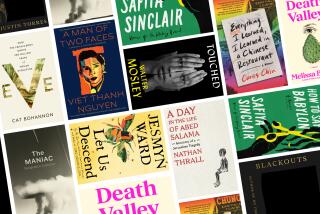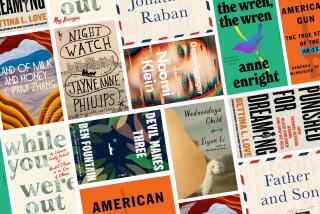BOOKS FOR KIDS
- Share via
THE SNAKE’S TALES
By Marguerite W. Davol
Illustrated by Yumi Heo
Scholastic/Orchard: 32 pp., $15.95
A smooth-tongued snake takes on the role of tempter--and raconteur--in a pleasing original story inspired by a Native American folk tale. “Once upon the time of no stories,” begins Marguerite W. Davol (“The Paper Dragon”), creating and maintaining an appropriately timeless aura. On separate occasions, siblings Beno and Allita are individually sent by their mother to gather fruit for the family. Each encounters a sly snake that offers to tell them stories in return for the fruit they’ve just picked. As neither child has ever heard a story before, each accepts the snake’s offer and is regaled with various myths and dramatic accounts. Mama and Papa, while deprived of strawberries and raspberries, are eventually rewarded with the entertaining fare that Beno and Allita have collected instead. Davol’s folk tale rhythm and simple imagery are just right for a tale about the origin of story. Yumi Heo (“One Sunday Morning”) creates a smiling, blank-eyed clan that recalls wooden dolls. Her cheerfully cluttered pencil-and-oil compositions hum with activity. Drawing her subjects first--people, chickens, fireflies, apple trees--then painting background colors around them and leaving bits of white paper exposed, Heo gives her work extra pop. (Ages 5-9)
*
DEAR MRS. LaRUE
Letters From Obedience School
By Mark Teague
Scholastic: 32 pp., $15.95
A dog’s life is hardly to be envied if one believes the words of Ike, a rambunctious pooch sentenced to obedience school by his exasperated owner, Mrs. LaRue. Having repeatedly terrorized the neighbors’ cats and snatched one snack too many from the kitchen counter, Ike finds himself enrolled at Igor Brotweiler Canine Academy. The hero begins a clever letter-writing campaign to Mrs. LaRue that paints a grim (and hopefully guilt-inducing) picture of his Brotweiler experience. But readers are privy to the hilarious truth. Mark Teague (“How Do Dinosaurs Say Good Night?”) depicts the pampered pup at the spa-like academy in brightly colored vignettes, juxtaposed with black-and-white prison-like scenes that illustrate Ike’s imagined hardship.
He composes his correspondence with dramatic flair, whether describing his “inmate” experience (“The guards here are all caught up in this ‘good dog, bad dog’ thing”) or reflecting on his misdeeds back at home (“Were the neighbors really complaining about my howling? ... Let’s recall that these are the same neighbors who are constantly waking me up in the middle of the afternoon with their loud vacuuming”). Throughout, the devilish laughs are in the details (waiters in white coats serving academy dogs gourmet meals and frozen drinks; Ike’s images of a hard life in striped prison garb plus ball and chain). Even the duo’s reunion (to much fanfare) plays off an earlier joke. All in all, a tail-wagger of a book that will have readers howling with amusement. (Ages 5-8)
*
911
The Book of Help
Edited by Michael Cart with Marc Aronson and Marianne Carus
Cricket/Marcato: 178 pp., $17.95, $9.95 paper
An impressive cast of more than 20 children’s book authors donated work to this highly personal, often affecting roundup of essays, short stories and poems inspired by the events of Sept. 11. Organized into four sections from “Healing” to “Reacting and Recovering,” the pieces range from related events triggered by the New York tragedy to writers’ evocations of the horrific images they viewed that morning. Arnold Adoff draws a correlation to the assassination of Martin Luther King Jr. in 1968 (“Souls rise / without reason long before their reasonable times”); David Paterson (son of fellow contributor Katherine Paterson) recounts perhaps the most immediate connection to the terrorist attacks as he relates his experience at ground zero on Sept. 13 with shovel in hand to help clear the rubble. In a candid entry, Walter Dean Myers recalls watching a Middle Eastern man in London cheering the loss of American lives: “He is my enemy because those who think like he does have brought violence and hatred to my door, and to the doors of those I love.”
Perhaps Susan Cooper (who heard the roar of a fighter plane in New York City on Sept. 11 and recalled the bombs that fell on her London neighborhood during World War II) best sums up the collection’s underlying message: “But the opposite of terror is hope, and ... hope can drive out fear.” Other contributors to this strong collection include Avi, Sharon Creech, Nikki Giovanni, Margaret Mahy and Naomi Shihab Nye; Chris Raschka provides an evocative cover and interior pen-and-inks for each section opener. The publisher will contribute a portion of the proceeds of this book to the Families of Freedom Scholarship Fund. (Ages 12 and older)
*
WITH THEIR EYES
September 11th--the view from a high school at ground zero
Edited by Annie Thoms
HarperTempest: 256 pp.,
$6.99 paper
Annie Thoms, an English teacher at Stuyvesant High School, located four blocks from the site of the World Trade Center, spearheaded a dramatic production at school last February based on 10 students’ recorded interviews (with classmates, faculty and staff members). The students converted the transcripts into “poem-monologues,” which they presented and the text of which appears here. In Thoms’ introduction, she notes that the goal was “to capture the ways individual people express themselves in speech,” and, indeed, the collective impression is one of a group therapy session that may well provide some healing for teen readers still struggling with the event’s aftermath.
Many of the monologues (at times laced with “um” and “like”) probably work better in a dramatization; on the page, the narratives at times falter and a few repeat similar themes. The poignant “Precious Cargo,” for instance, begins with a photograph of a student performing as a pregnant English teacher, and her words of protectiveness about both her unborn child and her students read well on the page but would likely be even more moving onstage. Still, the emotional rhythms of the volume take on a credible ebb and flow. A welcome dash of humor comes through in a freshman’s contention that the students’ relocation to Brooklyn Tech (while their school functioned as a triage center) put everyone on equal footing (“Everybody was like / ‘Where the hell are my classes?’ / so it was kinda like everybody was a freshman”).
In the closing entry, perhaps the most smoothly structured in the volume, the school theater manager recalls returning to a newly reopened Stuyvesant to find the flag missing from the stage. Later, he “came across a picture / of firemen / installing a flag / on the mast of the World Trade Center / and I looked at the picture and my jaw dropped. / It was our flag.” Readers willing to overlook less relevant and revealing segments will find a number of moving moments here. (Ages 13 and older)
More to Read
Sign up for our Book Club newsletter
Get the latest news, events and more from the Los Angeles Times Book Club, and help us get L.A. reading and talking.
You may occasionally receive promotional content from the Los Angeles Times.








